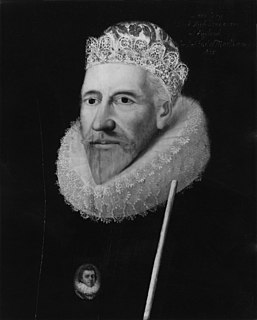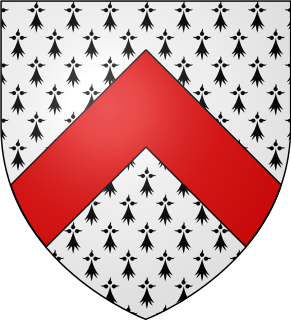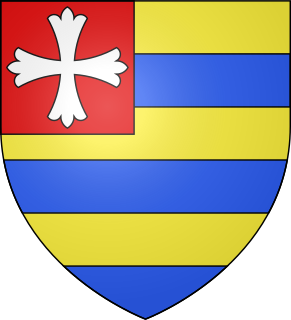The title of Baron Grey of Codnor is a title in the peerage of England.

Baron le Despencer is a title that has been created several times by writ in the Peerage of England.

Earl of Marlborough is a title that has been created twice, both times in the Peerage of England. The first time in 1626 in favour of James Ley, 1st Baron Ley and the second in 1689 for John Churchill, 1st Baron Churchill the future Duke of Marlborough.
The title Baron Multon de/of Egremont was created once in the Peerage of England. On 6 February 1299 Thomas de Multon was summoned to Parliament. On the death of the second baron, the barony fell into abeyance in 1334.
Edmund Stafford, 5th Earl of Stafford and 1st Baron Audley, KG, KB was the son of Hugh de Stafford, 2nd Earl of Stafford, and his wife Philippa de Beauchamp.
Margaret de Audley,suo jure2nd Baroness Audley and Countess of Stafford was an English noblewoman. She was the only daughter of Hugh de Audley, 1st Earl of Gloucester, by his wife Lady Margaret de Clare. Her mother was the daughter of Joan of Acre, Princess of England; thus making Margaret a great-granddaughter of King Edward I by his first consort, Eleanor of Castile. As the only daughter and heiress of her father, she succeeded to the title of 2nd Baroness Audley [E., 1317] on 10 November 1347.
Walter Fitz Robert of Woodham Walter, lord of Little Dunmow, Essex, was steward under Stephen of England, having succeeded to that position upon the death of his father, Robert Fitz Richard. Walter died in 1198 and was buried at Little Dunmow, in the choir of the priory of Austin canons.

de Lucy or de Luci is the surname of an old Norman noble family originating from Lucé in Normandy, one of the great baronial Anglo-Norman families which became rooted in England after the Norman conquest. The first records are about Adrian de Luci who went into England after William the Conqueror. The rise of this family might have been due to Henry I of England, although there are no historical proofs that all de Lucys belonged to the same family. The family name is Gallo-Roman, mentioned in 616 as Luciacus, Lucy, Luci, Lucé derive from the Latin cognomen Lucius, meaning "born with the daylight" or Gaulish Lucus, Lucius, Lucco from Loco- / Luco- possibly "wolf" + suffix -(i)acum "place, property" of Gaulish origin.
Edward Stafford, 4th Baron Stafford, was the son of Edward Stafford, 3rd Baron Stafford, and Mary Stanley, daughter of Edward Stanley, 3rd Earl of Derby, and Dorothy Howard. He became 4th Baron Stafford on the death of his father in 1603.
Roger Stafford, 6th Baron Stafford, was the son of Richard Stafford, a younger son of Henry Stafford, 1st Baron Stafford, and Ursula Pole. He was forced to give up the Stafford barony in 1637 on the grounds of poverty.
Edmund de Stafford, 1st Baron Stafford (1272/1273–1308), was the son of Nicholas de Stafford, who was summoned to parliament by writ on 6 February 1299 by King Edward I.

John Tuchet, 8th Baron Audley, 5th Baron Tuchet was an English peer.

Thomas de Multon, Lord of Egremont, was an English noble.

Richard Grey, 1st or 4th Baron Grey of Codnor KG was an English soldier and diplomat.

Baron Aton is an abeyant title in the Peerage of England. It was created by Writ of summons to Parliament of Gilbert de Aton of Ayton, North Yorkshire on 30 December 1324. It passed to his son William, but fell into abeyance upon the death of William without male heirs in 1373.
Baron Vesci was a title in the Peerage of England and Peerage of the United Kingdom. It existed as a feudal barony by tenure, before being created by Writ of summons to Parliament of John de Vesci in 1264 until his death in 1289. It was created a second time by writ of William de Vescy in 1295 until his death in 1297. It was created a third time in 1313 by writ of William de Vesci until his death in 1314. The title was created a fourth time by writ of Henry Bromflete, Lord Vescy in 1449 until it became extinct in 1469 upon his death. The title was created a fifth time for John Vesey, 4th Viscount de Vesci in 1884 until his death in 1903 when the title became extinct.
Admiral Sir Robert Morley or Robert de Morley, 2nd Baron Morley, was an English Knight and naval officer who served as Admiral of the North four times from in the service of King Edward III.

Richard de Luci, sometimes spelt Lucy, Baron of Egremont and Copeland, was an English noble.
Lambert de Multon Baron of Copeland, Lord of Egremont, Lord of Moulton who also held lands in Fleet, Moulton and Sutton, was an English noble.
Alan de Multon, Lord of Papcastle, who held lands in Cockermouth, was an English noble.








